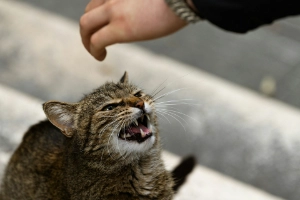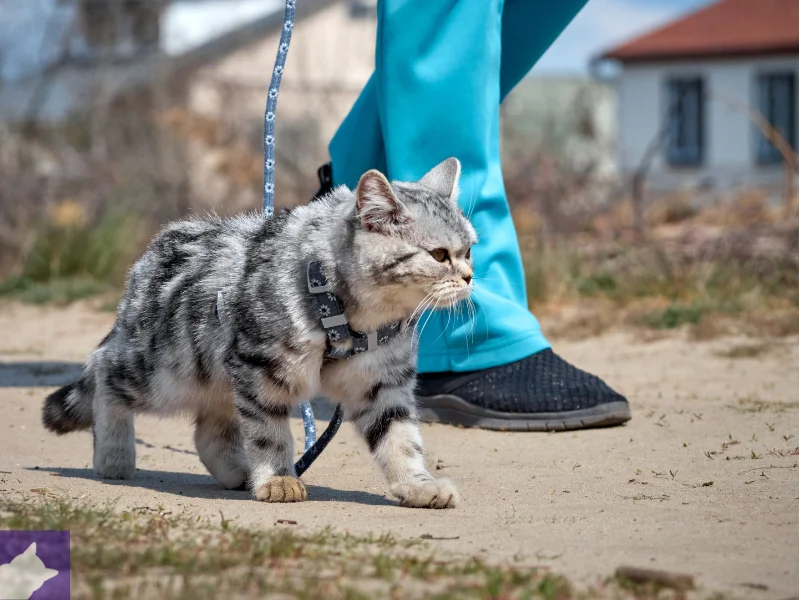
We may earn a commission when you purchase via our links at no extra cost to you.
We only share resources that meet our high standards
Introduction
Few things alarm cat owners more than sudden signs of aggression. A hiss, a swat, or even a bite can feel like a betrayal, especially when it comes from a beloved pet. But cat aggression is not a sign of “meanness.” Instead, it’s a natural behavior that usually signals fear, frustration, pain, or a misunderstanding of their environment.
This guide explains the causes of cat aggression, the different types, and practical solutions you can apply at home. Whether you’re a first-time cat parent or a lifelong feline friend, you’ll learn how to keep your cat safe, happy, and harmonious.
What Is Cat Aggression?
Cat aggression refers to hostile or defensive behaviours like hissing, growling, biting, or scratching. Unlike playful batting or pouncing, aggression is intended to ward off or harm a perceived threat.
For beginners, it’s important to distinguish between playful energy and true aggression. Cats often chase, bite gently, and wrestle during play, but their claws stay sheathed, and they don’t growl or hiss.
To understand the signals your cat gives before aggression escalates, see our guide: Understanding Cat Body Language.
Common Causes of Cat Aggression
Aggression is rarely random. Most cats lash out for a reason:
- Fear and stress – New environments, loud noises, or strangers can trigger defensive aggression.
- Territorial instincts – Cats naturally defend their home turf from intruders (other cats, pets, or even people).
- Redirected aggression – If a cat sees something frustrating (like another cat outside) but can’t reach it, they may redirect anger onto whoever is nearby.
- Pain or medical issues – Arthritis, dental disease, or injuries can make cats lash out when touched.
- Poor socialization – Kittens not exposed to gentle handling may grow into adults who react aggressively to touch.
Types of Cat Aggression
According to the Cornell Feline Health Center, ASPCA, and other experts, aggression can be grouped into several categories:
- Fear-based aggression – The most common type; triggered by perceived threats.
- Territorial aggression – Cats may attack newcomers or fight over favorite spaces.
- Play-related aggression – Common in kittens and young cats who use biting and pouncing in play.
- Redirected aggression – Occurs when a cat lashes out at someone nearby after being provoked by something else.
- Maternal aggression – Mother cats may aggressively defend kittens from perceived danger.
- Status-related aggression – Cats sometimes fight to establish dominance in multi-cat homes.
How to Recognize Aggression Early
Cats usually warn before attacking. Recognizing early signs helps prevent escalation.
Signs of Aggression:

Ears Flattened Back

Tail Lashing

Pupils Dilated

Body Crouched

Low Growl or Hiss
Playful Cat vs Aggression Cat
| Behavior | Playful Cat | Aggressive Cat |
| Ears | Upright, forward | Flat, pinned back |
| Caws | Usually retracted | Extended, swiping |
| Vocalizations | Quiet, chirps | Hissing, growling |
| Body Posture | Relaxed, bouncy | Tense, crouched, arched |
| Intensity | Short bursts, pauses | Escalates quickly, sustained |
Safe Solutions: How to calm an aggressive cat
Aggression requires patience, not punishment. Follow these steps to handle it safely:

- Identify the trigger
Observe what sparks the behavior (other pets, loud sounds, certain touches). - Give space
Never corner or grab an aggressive cat. Step back and let them calm down. - Redirect energy
Offer toys like wands, balls, or puzzle feeders to channel hunting instincts. - Provide safe zones
Cats feel calmer with high perches, hiding spots, or separate rooms. - Maintain routine
Cats thrive on predictability. Feeding and play at regular times reduces stress. - Use calming aids
Feliway diffusers, soft sounds, or calming supplements may help reduce anxiety. - Seek professional help
If aggression escalates, consult a vet or certified behaviorist. Medical conditions must be ruled out first.
Preventing Future Aggression

The best way to deal with aggression is to stop it from developing:
- Proper introductions – Slowly introduce new cats or pets using scent swapping and gradual meetings.
- Enrichment – Play sessions twice daily reduce boredom-based aggression.
- Routine vet check-ups – Detects pain or illness before it affects behavior.
- Trust building – Reward calm behavior with treats and avoid forcing interaction.
Common Mistakes to Avoid
- ❌ Yelling or punishing
Increases fear and worsens aggression. - ❌ Forcing contact
Let your cat come to you on their terms. - ❌ Ignoring health issues
Always rule out pain or illness first. - ❌ Overstimulation
Learn your cat’s tolerance for petting; stop before they swat.
FAQs About Cat Aggression
1. Why is my cat suddenly aggressive?
Sudden aggression often signals pain or illness. Schedule a vet check before assuming it’s behavioral.
2. Can cats grow out of aggression?
Kittens may outgrow play-aggression with training, but fear-based or medical aggression requires management.
3. Should I punish my cat for biting?
No. Punishment damages trust and escalates aggression. Instead, redirect to toys and give space.
4. Is aggression more common in certain breeds?
Any breed can show aggression, though active breeds (like Bengals or Siamese) may be more prone to play-aggression.
5. Do male cats get more aggressive than females?
Unneutered males are more likely to fight. Spaying/neutering greatly reduces aggression in both sexes.
6. When should I see a vet about aggression?
If aggression is sudden, severe, or injures people/pets, seek veterinary or behavioral help immediately.
Key Takeaways
- Cat aggression is a symptom, not a personality flaw.
- Most aggression comes from fear, pain, or frustration.
- Recognizing early warning signs prevents bites and scratches.
- Solutions include safe spaces, enrichment, and consistency.
- Never punish, focus on trust and positive reinforcement.
Conclusion
Cat aggression can be stressful, but it’s not hopeless. By understanding the underlying cause, respecting your cat’s boundaries, and applying safe strategies, you can transform tension into trust.
If your cat’s aggression seems unmanageable, don’t wait—consult your veterinarian or a certified behaviorist. With patience, compassion, and the right tools, harmony in your home is possible.






